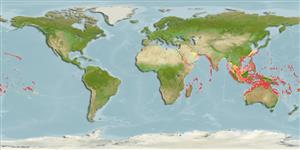Environment: milieu / climate zone / depth range / distribution range
Écologie
marin récifal; profondeur 0 - 120 m (Ref. 128797). Tropical; 30°N - 36°S, 24°E - 124°W
Indo-Pacific: East Africa eastward through northern Australia to Hawaiian, Marquesas and Pitcairn islands, north to south Japan.
Taille / Poids / Âge
Maturity: Lm ? range ? - ? cm
Max length : 25.0 cm TL mâle / non sexé; (Ref. 4420)
Épines dorsales (Total): 3; Rayons mous dorsaux (Total): 27-30; Épines anales 0; Rayons mous anaux: 25 - 27. The characteristic scythe mark crossing the pectoral base is yellowish-tan to green in juveniles and subadults.
Inhabit clear inner and outer reef habitats from exposed algae reef flats to deep along drop-offs (Ref. 48637). Occur in seaward reefs below the surge zone (Ref. 205). Benthopelagic (Ref. 58302). Feed on crabs, bivalves, gastropods, algae, echinoids, tunicates, worms, eggs, and detritus. Oviparous (Ref. 205). Also taken by drive-in nets (Ref. 9770).
Life cycle and mating behavior
Maturité | Reproduction | Frai | Œufs | Fécondité | Larves
Distinct pairing (Ref. 205).
Myers, R.F., 1991. Micronesian reef fishes. Second Ed. Coral Graphics, Barrigada, Guam. 298 p. (Ref. 1602)
Statut dans la liste rouge de l'IUCN (Ref. 130435)
Menace pour l'homme
Harmless
Utilisations par l'homme
Pêcheries: intérêt commercial mineur; Aquarium: Commercial
Plus d'informations
RéférencesAquacultureProfil d'aquacultureSouchesGénétiqueElectrophoresesHéritabilitéPathologiesTraitementNutrientsMass conversion
Outils
Articles particuliers
Télécharger en XML
Sources Internet
Estimates based on models
Preferred temperature (Ref.
123201): 24.5 - 28.8, mean 27.4 °C (based on 596 cells).
Phylogenetic diversity index (Ref.
82804): PD
50 = 0.5312 [Uniqueness, from 0.5 = low to 2.0 = high].
Bayesian length-weight: a=0.02570 (0.01232 - 0.05364), b=2.94 (2.77 - 3.11), in cm total length, based on LWR estimates for this (Sub)family-body shape (Ref.
93245).
Niveau trophique (Ref.
69278): 2.9 ±0.0 se; based on diet studies.
Résilience (Ref.
120179): Haut, temps minimum de doublement de population inférieur à 15 mois (Preliminary K or Fecundity.).
Fishing Vulnerability (Ref.
59153): Low vulnerability (15 of 100).
Nutrients (Ref.
124155): Calcium = 52.5 [22.6, 119.3] mg/100g; Iron = 0.666 [0.346, 1.486] mg/100g; Protein = 18.1 [16.0, 20.3] %; Omega3 = 0.121 [0.061, 0.238] g/100g; Selenium = 38.9 [19.8, 81.7] μg/100g; VitaminA = 54.3 [15.1, 197.2] μg/100g; Zinc = 1.24 [0.83, 1.83] mg/100g (wet weight);
